Challenges in Cyber Security for Business
VerifiedAdded on 2020/03/07
|14
|3343
|45
Report
AI Summary
This report discusses the challenges faced by the banking industry in terms of cyber security, including threats, objectives, and recommended measures to enhance security protocols. It highlights the importance of protecting sensitive data and maintaining compliance with regulations, while also reviewing literature on the evolving landscape of cyber threats. The report concludes with a focus on the need for continuous improvement in cyber security practices within the banking sector.
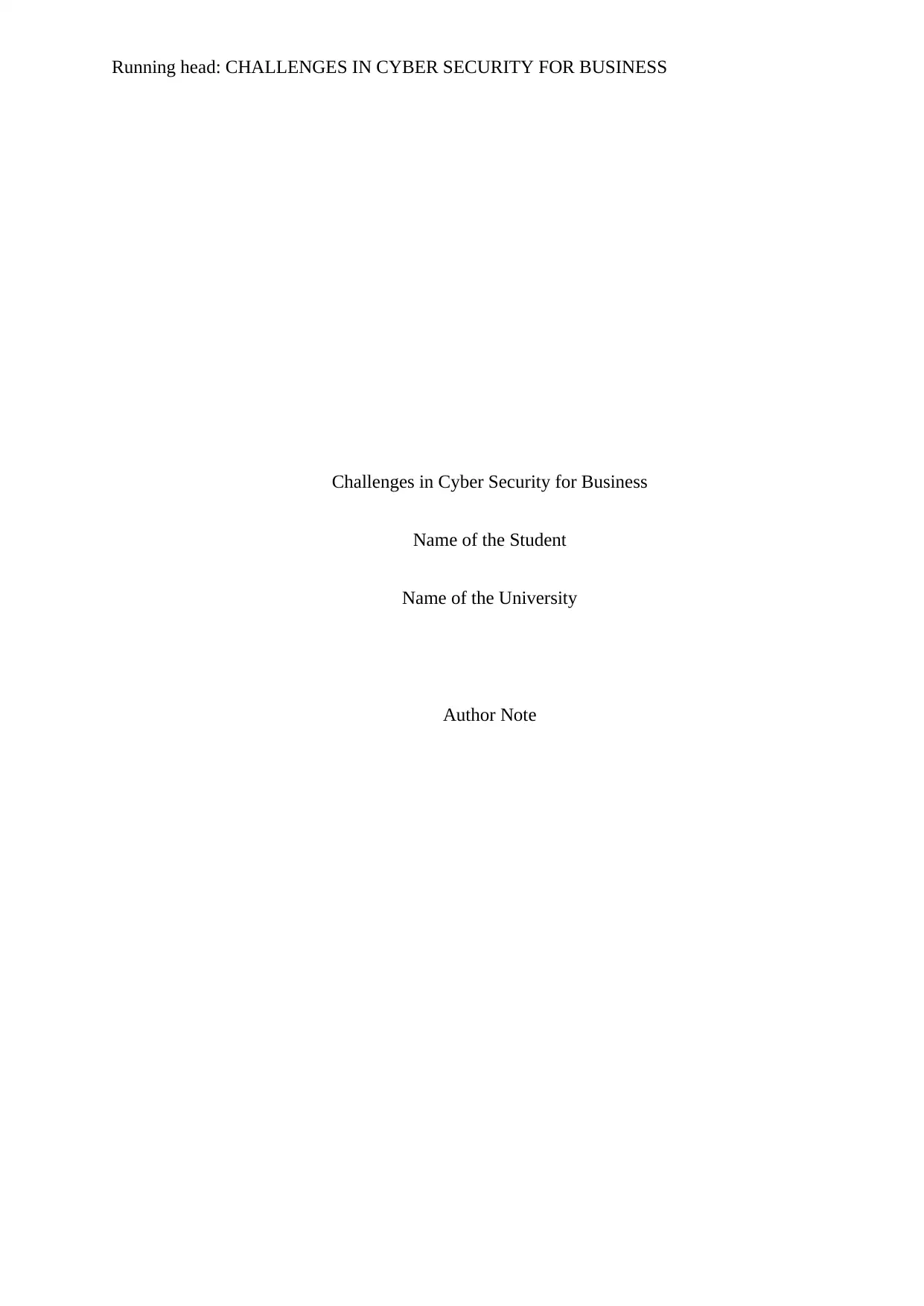
Running head: CHALLENGES IN CYBER SECURITY FOR BUSINESS
Challenges in Cyber Security for Business
Name of the Student
Name of the University
Author Note
Challenges in Cyber Security for Business
Name of the Student
Name of the University
Author Note
Paraphrase This Document
Need a fresh take? Get an instant paraphrase of this document with our AI Paraphraser
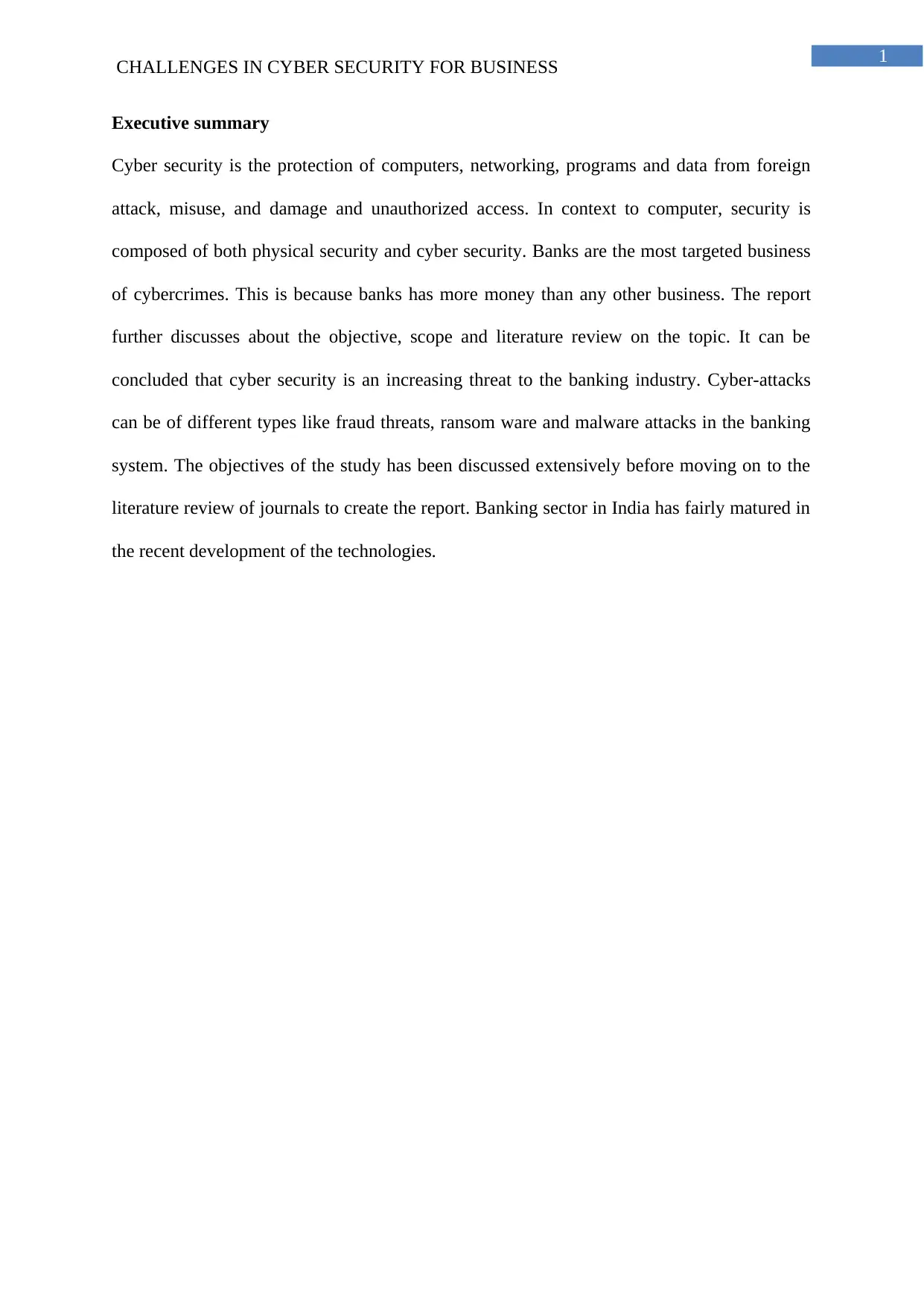
1
CHALLENGES IN CYBER SECURITY FOR BUSINESS
Executive summary
Cyber security is the protection of computers, networking, programs and data from foreign
attack, misuse, and damage and unauthorized access. In context to computer, security is
composed of both physical security and cyber security. Banks are the most targeted business
of cybercrimes. This is because banks has more money than any other business. The report
further discusses about the objective, scope and literature review on the topic. It can be
concluded that cyber security is an increasing threat to the banking industry. Cyber-attacks
can be of different types like fraud threats, ransom ware and malware attacks in the banking
system. The objectives of the study has been discussed extensively before moving on to the
literature review of journals to create the report. Banking sector in India has fairly matured in
the recent development of the technologies.
CHALLENGES IN CYBER SECURITY FOR BUSINESS
Executive summary
Cyber security is the protection of computers, networking, programs and data from foreign
attack, misuse, and damage and unauthorized access. In context to computer, security is
composed of both physical security and cyber security. Banks are the most targeted business
of cybercrimes. This is because banks has more money than any other business. The report
further discusses about the objective, scope and literature review on the topic. It can be
concluded that cyber security is an increasing threat to the banking industry. Cyber-attacks
can be of different types like fraud threats, ransom ware and malware attacks in the banking
system. The objectives of the study has been discussed extensively before moving on to the
literature review of journals to create the report. Banking sector in India has fairly matured in
the recent development of the technologies.
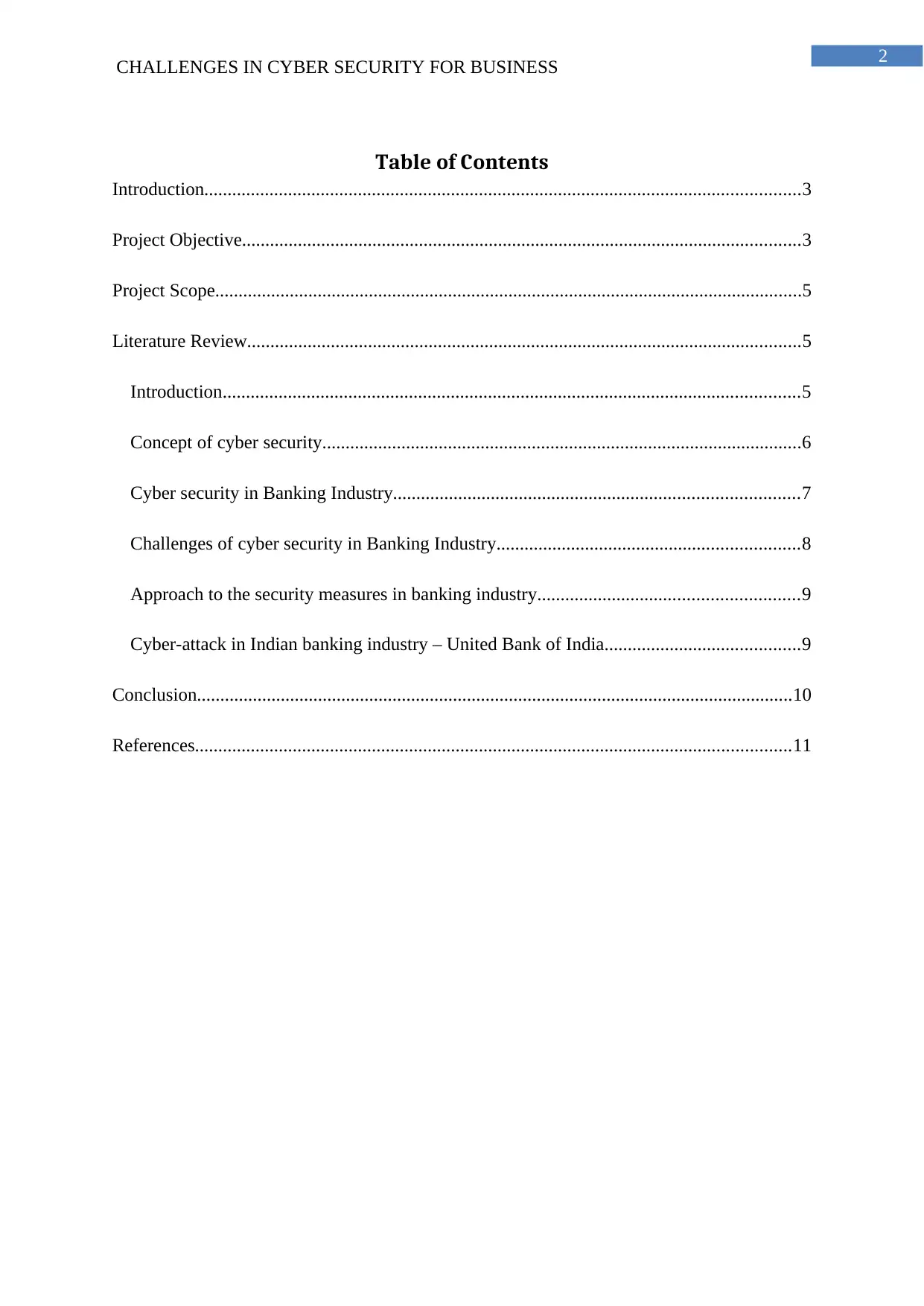
2
CHALLENGES IN CYBER SECURITY FOR BUSINESS
Table of Contents
Introduction................................................................................................................................3
Project Objective........................................................................................................................3
Project Scope..............................................................................................................................5
Literature Review.......................................................................................................................5
Introduction............................................................................................................................5
Concept of cyber security.......................................................................................................6
Cyber security in Banking Industry.......................................................................................7
Challenges of cyber security in Banking Industry.................................................................8
Approach to the security measures in banking industry........................................................9
Cyber-attack in Indian banking industry – United Bank of India..........................................9
Conclusion................................................................................................................................10
References................................................................................................................................11
CHALLENGES IN CYBER SECURITY FOR BUSINESS
Table of Contents
Introduction................................................................................................................................3
Project Objective........................................................................................................................3
Project Scope..............................................................................................................................5
Literature Review.......................................................................................................................5
Introduction............................................................................................................................5
Concept of cyber security.......................................................................................................6
Cyber security in Banking Industry.......................................................................................7
Challenges of cyber security in Banking Industry.................................................................8
Approach to the security measures in banking industry........................................................9
Cyber-attack in Indian banking industry – United Bank of India..........................................9
Conclusion................................................................................................................................10
References................................................................................................................................11
⊘ This is a preview!⊘
Do you want full access?
Subscribe today to unlock all pages.

Trusted by 1+ million students worldwide
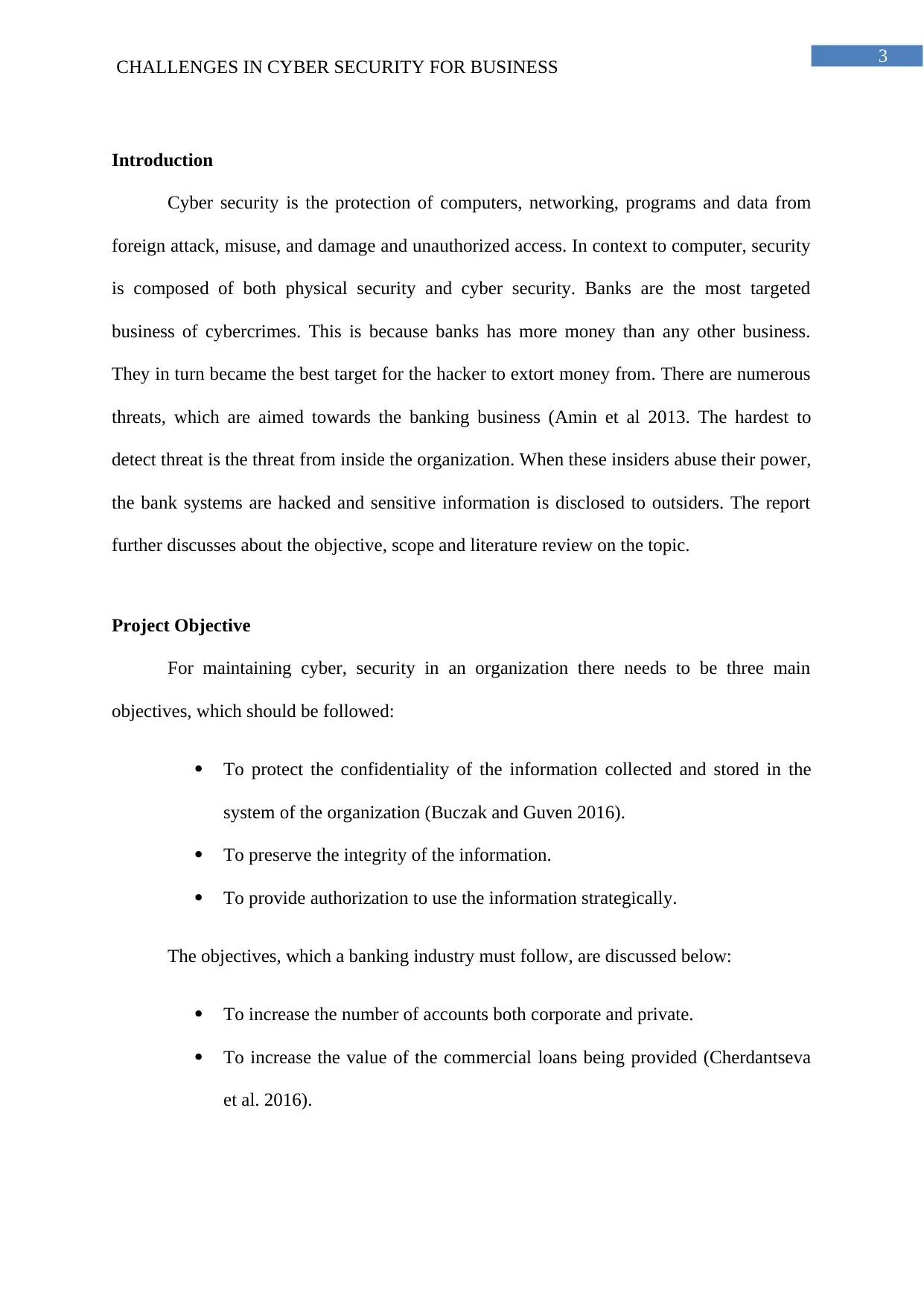
3
CHALLENGES IN CYBER SECURITY FOR BUSINESS
Introduction
Cyber security is the protection of computers, networking, programs and data from
foreign attack, misuse, and damage and unauthorized access. In context to computer, security
is composed of both physical security and cyber security. Banks are the most targeted
business of cybercrimes. This is because banks has more money than any other business.
They in turn became the best target for the hacker to extort money from. There are numerous
threats, which are aimed towards the banking business (Amin et al 2013. The hardest to
detect threat is the threat from inside the organization. When these insiders abuse their power,
the bank systems are hacked and sensitive information is disclosed to outsiders. The report
further discusses about the objective, scope and literature review on the topic.
Project Objective
For maintaining cyber, security in an organization there needs to be three main
objectives, which should be followed:
To protect the confidentiality of the information collected and stored in the
system of the organization (Buczak and Guven 2016).
To preserve the integrity of the information.
To provide authorization to use the information strategically.
The objectives, which a banking industry must follow, are discussed below:
To increase the number of accounts both corporate and private.
To increase the value of the commercial loans being provided (Cherdantseva
et al. 2016).
CHALLENGES IN CYBER SECURITY FOR BUSINESS
Introduction
Cyber security is the protection of computers, networking, programs and data from
foreign attack, misuse, and damage and unauthorized access. In context to computer, security
is composed of both physical security and cyber security. Banks are the most targeted
business of cybercrimes. This is because banks has more money than any other business.
They in turn became the best target for the hacker to extort money from. There are numerous
threats, which are aimed towards the banking business (Amin et al 2013. The hardest to
detect threat is the threat from inside the organization. When these insiders abuse their power,
the bank systems are hacked and sensitive information is disclosed to outsiders. The report
further discusses about the objective, scope and literature review on the topic.
Project Objective
For maintaining cyber, security in an organization there needs to be three main
objectives, which should be followed:
To protect the confidentiality of the information collected and stored in the
system of the organization (Buczak and Guven 2016).
To preserve the integrity of the information.
To provide authorization to use the information strategically.
The objectives, which a banking industry must follow, are discussed below:
To increase the number of accounts both corporate and private.
To increase the value of the commercial loans being provided (Cherdantseva
et al. 2016).
Paraphrase This Document
Need a fresh take? Get an instant paraphrase of this document with our AI Paraphraser
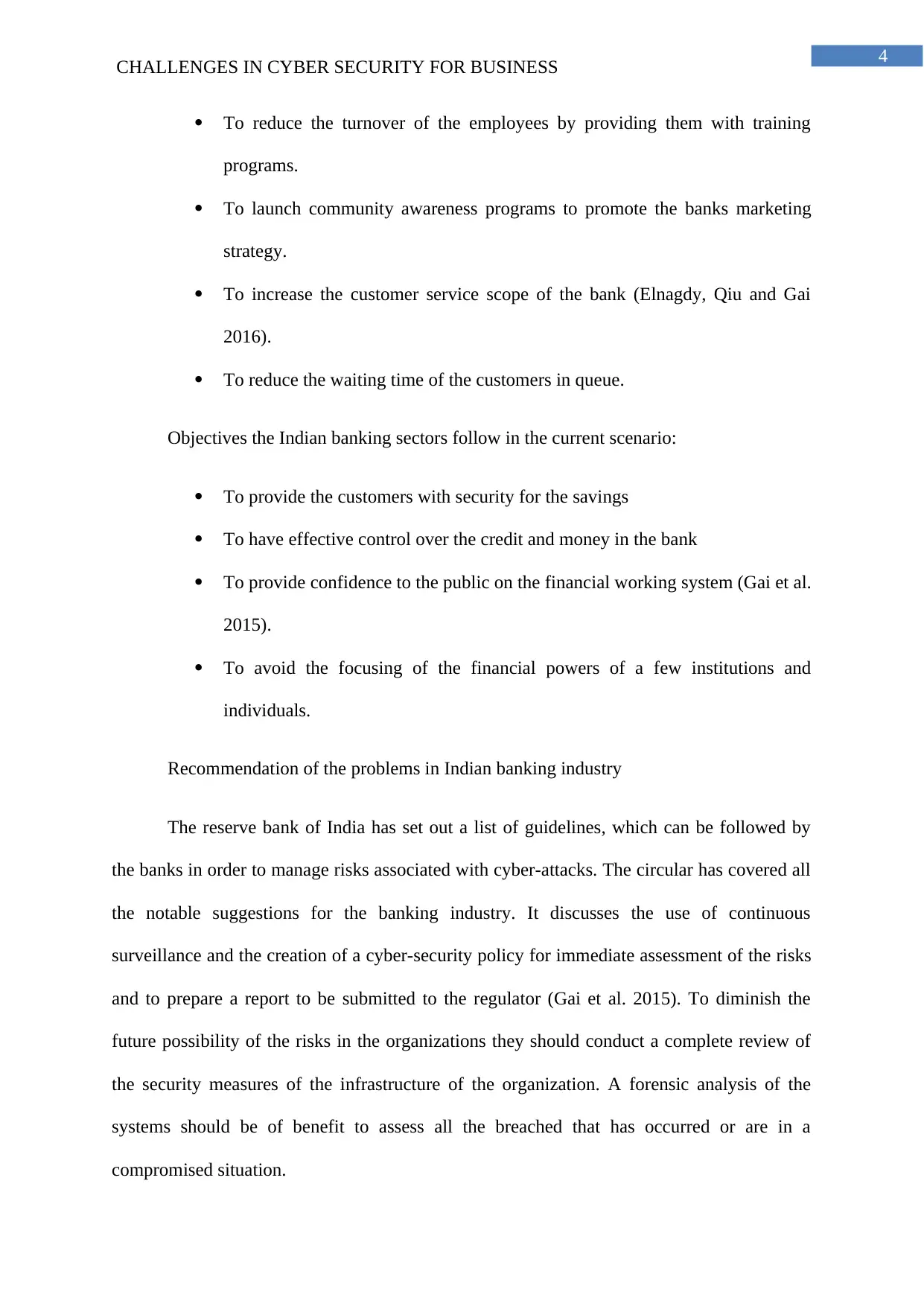
4
CHALLENGES IN CYBER SECURITY FOR BUSINESS
To reduce the turnover of the employees by providing them with training
programs.
To launch community awareness programs to promote the banks marketing
strategy.
To increase the customer service scope of the bank (Elnagdy, Qiu and Gai
2016).
To reduce the waiting time of the customers in queue.
Objectives the Indian banking sectors follow in the current scenario:
To provide the customers with security for the savings
To have effective control over the credit and money in the bank
To provide confidence to the public on the financial working system (Gai et al.
2015).
To avoid the focusing of the financial powers of a few institutions and
individuals.
Recommendation of the problems in Indian banking industry
The reserve bank of India has set out a list of guidelines, which can be followed by
the banks in order to manage risks associated with cyber-attacks. The circular has covered all
the notable suggestions for the banking industry. It discusses the use of continuous
surveillance and the creation of a cyber-security policy for immediate assessment of the risks
and to prepare a report to be submitted to the regulator (Gai et al. 2015). To diminish the
future possibility of the risks in the organizations they should conduct a complete review of
the security measures of the infrastructure of the organization. A forensic analysis of the
systems should be of benefit to assess all the breached that has occurred or are in a
compromised situation.
CHALLENGES IN CYBER SECURITY FOR BUSINESS
To reduce the turnover of the employees by providing them with training
programs.
To launch community awareness programs to promote the banks marketing
strategy.
To increase the customer service scope of the bank (Elnagdy, Qiu and Gai
2016).
To reduce the waiting time of the customers in queue.
Objectives the Indian banking sectors follow in the current scenario:
To provide the customers with security for the savings
To have effective control over the credit and money in the bank
To provide confidence to the public on the financial working system (Gai et al.
2015).
To avoid the focusing of the financial powers of a few institutions and
individuals.
Recommendation of the problems in Indian banking industry
The reserve bank of India has set out a list of guidelines, which can be followed by
the banks in order to manage risks associated with cyber-attacks. The circular has covered all
the notable suggestions for the banking industry. It discusses the use of continuous
surveillance and the creation of a cyber-security policy for immediate assessment of the risks
and to prepare a report to be submitted to the regulator (Gai et al. 2015). To diminish the
future possibility of the risks in the organizations they should conduct a complete review of
the security measures of the infrastructure of the organization. A forensic analysis of the
systems should be of benefit to assess all the breached that has occurred or are in a
compromised situation.
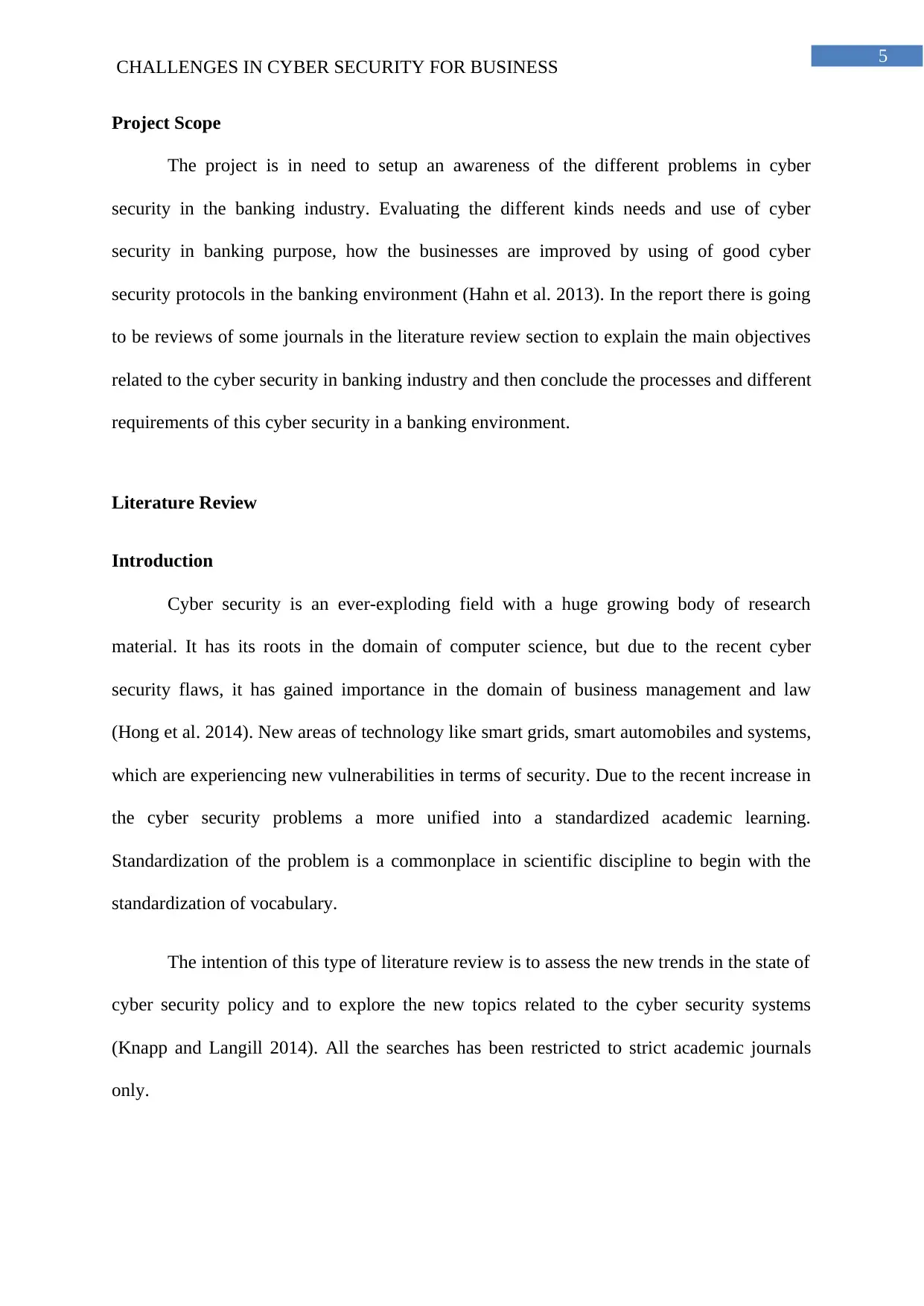
5
CHALLENGES IN CYBER SECURITY FOR BUSINESS
Project Scope
The project is in need to setup an awareness of the different problems in cyber
security in the banking industry. Evaluating the different kinds needs and use of cyber
security in banking purpose, how the businesses are improved by using of good cyber
security protocols in the banking environment (Hahn et al. 2013). In the report there is going
to be reviews of some journals in the literature review section to explain the main objectives
related to the cyber security in banking industry and then conclude the processes and different
requirements of this cyber security in a banking environment.
Literature Review
Introduction
Cyber security is an ever-exploding field with a huge growing body of research
material. It has its roots in the domain of computer science, but due to the recent cyber
security flaws, it has gained importance in the domain of business management and law
(Hong et al. 2014). New areas of technology like smart grids, smart automobiles and systems,
which are experiencing new vulnerabilities in terms of security. Due to the recent increase in
the cyber security problems a more unified into a standardized academic learning.
Standardization of the problem is a commonplace in scientific discipline to begin with the
standardization of vocabulary.
The intention of this type of literature review is to assess the new trends in the state of
cyber security policy and to explore the new topics related to the cyber security systems
(Knapp and Langill 2014). All the searches has been restricted to strict academic journals
only.
CHALLENGES IN CYBER SECURITY FOR BUSINESS
Project Scope
The project is in need to setup an awareness of the different problems in cyber
security in the banking industry. Evaluating the different kinds needs and use of cyber
security in banking purpose, how the businesses are improved by using of good cyber
security protocols in the banking environment (Hahn et al. 2013). In the report there is going
to be reviews of some journals in the literature review section to explain the main objectives
related to the cyber security in banking industry and then conclude the processes and different
requirements of this cyber security in a banking environment.
Literature Review
Introduction
Cyber security is an ever-exploding field with a huge growing body of research
material. It has its roots in the domain of computer science, but due to the recent cyber
security flaws, it has gained importance in the domain of business management and law
(Hong et al. 2014). New areas of technology like smart grids, smart automobiles and systems,
which are experiencing new vulnerabilities in terms of security. Due to the recent increase in
the cyber security problems a more unified into a standardized academic learning.
Standardization of the problem is a commonplace in scientific discipline to begin with the
standardization of vocabulary.
The intention of this type of literature review is to assess the new trends in the state of
cyber security policy and to explore the new topics related to the cyber security systems
(Knapp and Langill 2014). All the searches has been restricted to strict academic journals
only.
⊘ This is a preview!⊘
Do you want full access?
Subscribe today to unlock all pages.

Trusted by 1+ million students worldwide
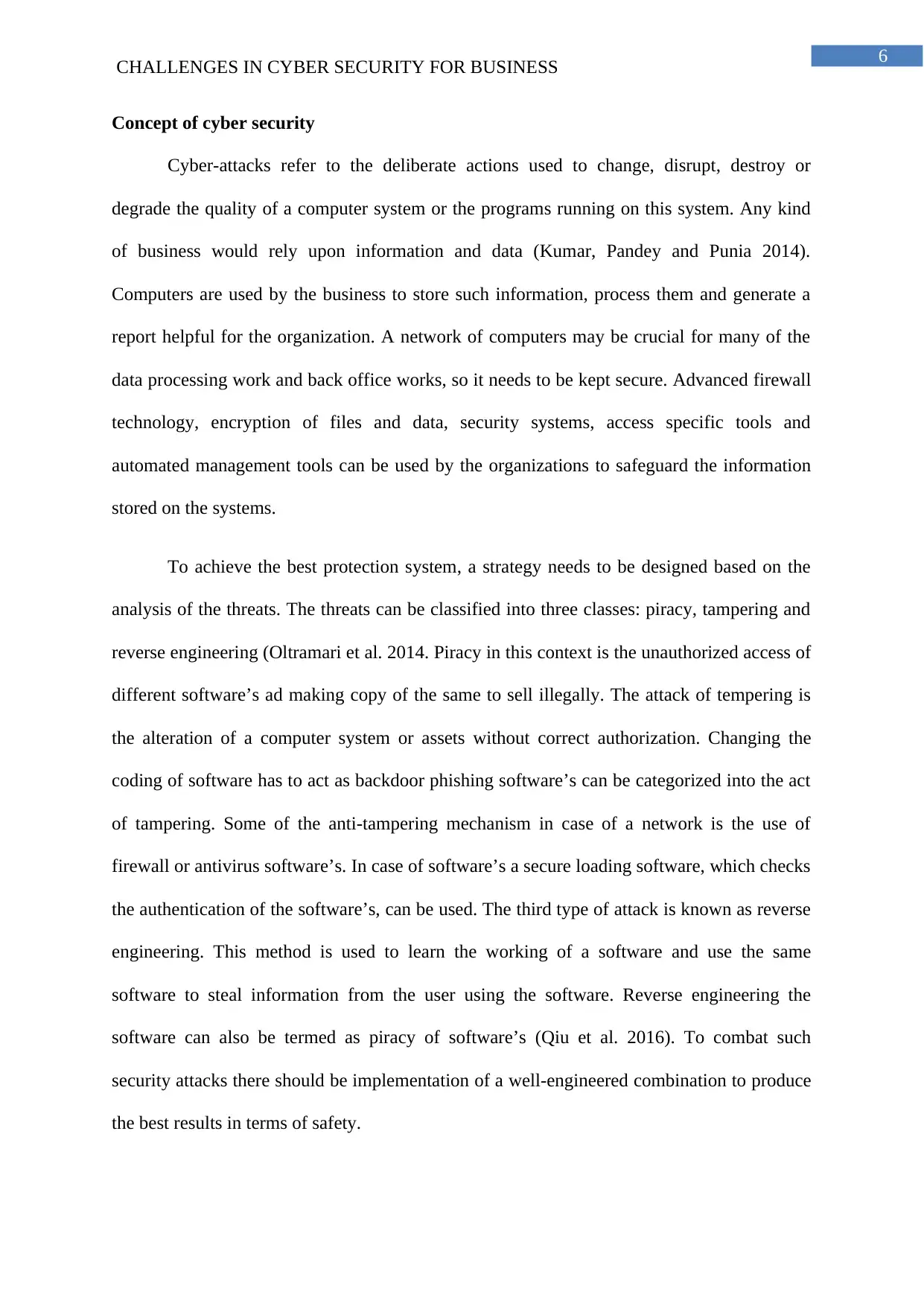
6
CHALLENGES IN CYBER SECURITY FOR BUSINESS
Concept of cyber security
Cyber-attacks refer to the deliberate actions used to change, disrupt, destroy or
degrade the quality of a computer system or the programs running on this system. Any kind
of business would rely upon information and data (Kumar, Pandey and Punia 2014).
Computers are used by the business to store such information, process them and generate a
report helpful for the organization. A network of computers may be crucial for many of the
data processing work and back office works, so it needs to be kept secure. Advanced firewall
technology, encryption of files and data, security systems, access specific tools and
automated management tools can be used by the organizations to safeguard the information
stored on the systems.
To achieve the best protection system, a strategy needs to be designed based on the
analysis of the threats. The threats can be classified into three classes: piracy, tampering and
reverse engineering (Oltramari et al. 2014. Piracy in this context is the unauthorized access of
different software’s ad making copy of the same to sell illegally. The attack of tempering is
the alteration of a computer system or assets without correct authorization. Changing the
coding of software has to act as backdoor phishing software’s can be categorized into the act
of tampering. Some of the anti-tampering mechanism in case of a network is the use of
firewall or antivirus software’s. In case of software’s a secure loading software, which checks
the authentication of the software’s, can be used. The third type of attack is known as reverse
engineering. This method is used to learn the working of a software and use the same
software to steal information from the user using the software. Reverse engineering the
software can also be termed as piracy of software’s (Qiu et al. 2016). To combat such
security attacks there should be implementation of a well-engineered combination to produce
the best results in terms of safety.
CHALLENGES IN CYBER SECURITY FOR BUSINESS
Concept of cyber security
Cyber-attacks refer to the deliberate actions used to change, disrupt, destroy or
degrade the quality of a computer system or the programs running on this system. Any kind
of business would rely upon information and data (Kumar, Pandey and Punia 2014).
Computers are used by the business to store such information, process them and generate a
report helpful for the organization. A network of computers may be crucial for many of the
data processing work and back office works, so it needs to be kept secure. Advanced firewall
technology, encryption of files and data, security systems, access specific tools and
automated management tools can be used by the organizations to safeguard the information
stored on the systems.
To achieve the best protection system, a strategy needs to be designed based on the
analysis of the threats. The threats can be classified into three classes: piracy, tampering and
reverse engineering (Oltramari et al. 2014. Piracy in this context is the unauthorized access of
different software’s ad making copy of the same to sell illegally. The attack of tempering is
the alteration of a computer system or assets without correct authorization. Changing the
coding of software has to act as backdoor phishing software’s can be categorized into the act
of tampering. Some of the anti-tampering mechanism in case of a network is the use of
firewall or antivirus software’s. In case of software’s a secure loading software, which checks
the authentication of the software’s, can be used. The third type of attack is known as reverse
engineering. This method is used to learn the working of a software and use the same
software to steal information from the user using the software. Reverse engineering the
software can also be termed as piracy of software’s (Qiu et al. 2016). To combat such
security attacks there should be implementation of a well-engineered combination to produce
the best results in terms of safety.
Paraphrase This Document
Need a fresh take? Get an instant paraphrase of this document with our AI Paraphraser
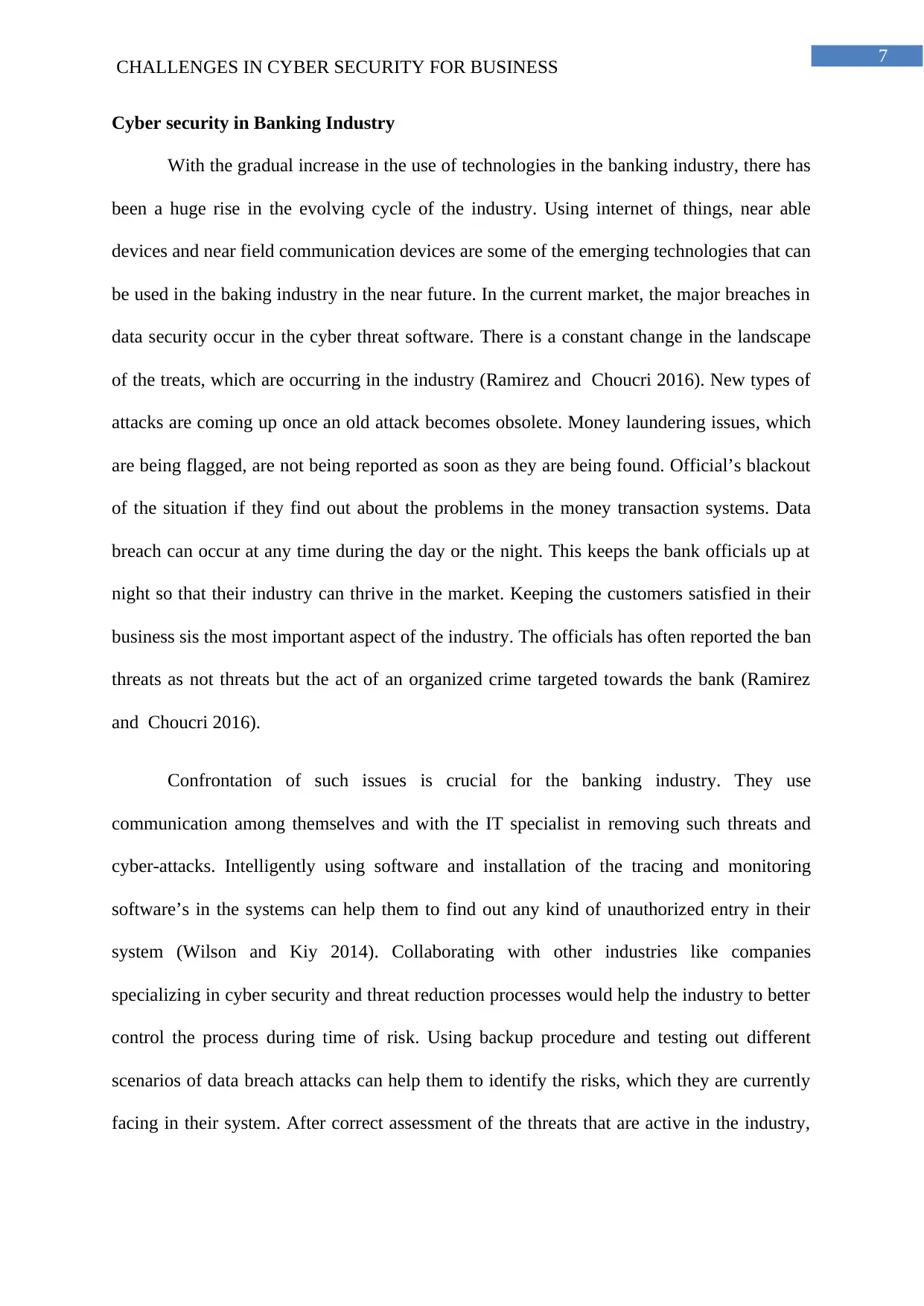
7
CHALLENGES IN CYBER SECURITY FOR BUSINESS
Cyber security in Banking Industry
With the gradual increase in the use of technologies in the banking industry, there has
been a huge rise in the evolving cycle of the industry. Using internet of things, near able
devices and near field communication devices are some of the emerging technologies that can
be used in the baking industry in the near future. In the current market, the major breaches in
data security occur in the cyber threat software. There is a constant change in the landscape
of the treats, which are occurring in the industry (Ramirez and Choucri 2016). New types of
attacks are coming up once an old attack becomes obsolete. Money laundering issues, which
are being flagged, are not being reported as soon as they are being found. Official’s blackout
of the situation if they find out about the problems in the money transaction systems. Data
breach can occur at any time during the day or the night. This keeps the bank officials up at
night so that their industry can thrive in the market. Keeping the customers satisfied in their
business sis the most important aspect of the industry. The officials has often reported the ban
threats as not threats but the act of an organized crime targeted towards the bank (Ramirez
and Choucri 2016).
Confrontation of such issues is crucial for the banking industry. They use
communication among themselves and with the IT specialist in removing such threats and
cyber-attacks. Intelligently using software and installation of the tracing and monitoring
software’s in the systems can help them to find out any kind of unauthorized entry in their
system (Wilson and Kiy 2014). Collaborating with other industries like companies
specializing in cyber security and threat reduction processes would help the industry to better
control the process during time of risk. Using backup procedure and testing out different
scenarios of data breach attacks can help them to identify the risks, which they are currently
facing in their system. After correct assessment of the threats that are active in the industry,
CHALLENGES IN CYBER SECURITY FOR BUSINESS
Cyber security in Banking Industry
With the gradual increase in the use of technologies in the banking industry, there has
been a huge rise in the evolving cycle of the industry. Using internet of things, near able
devices and near field communication devices are some of the emerging technologies that can
be used in the baking industry in the near future. In the current market, the major breaches in
data security occur in the cyber threat software. There is a constant change in the landscape
of the treats, which are occurring in the industry (Ramirez and Choucri 2016). New types of
attacks are coming up once an old attack becomes obsolete. Money laundering issues, which
are being flagged, are not being reported as soon as they are being found. Official’s blackout
of the situation if they find out about the problems in the money transaction systems. Data
breach can occur at any time during the day or the night. This keeps the bank officials up at
night so that their industry can thrive in the market. Keeping the customers satisfied in their
business sis the most important aspect of the industry. The officials has often reported the ban
threats as not threats but the act of an organized crime targeted towards the bank (Ramirez
and Choucri 2016).
Confrontation of such issues is crucial for the banking industry. They use
communication among themselves and with the IT specialist in removing such threats and
cyber-attacks. Intelligently using software and installation of the tracing and monitoring
software’s in the systems can help them to find out any kind of unauthorized entry in their
system (Wilson and Kiy 2014). Collaborating with other industries like companies
specializing in cyber security and threat reduction processes would help the industry to better
control the process during time of risk. Using backup procedure and testing out different
scenarios of data breach attacks can help them to identify the risks, which they are currently
facing in their system. After correct assessment of the threats that are active in the industry,
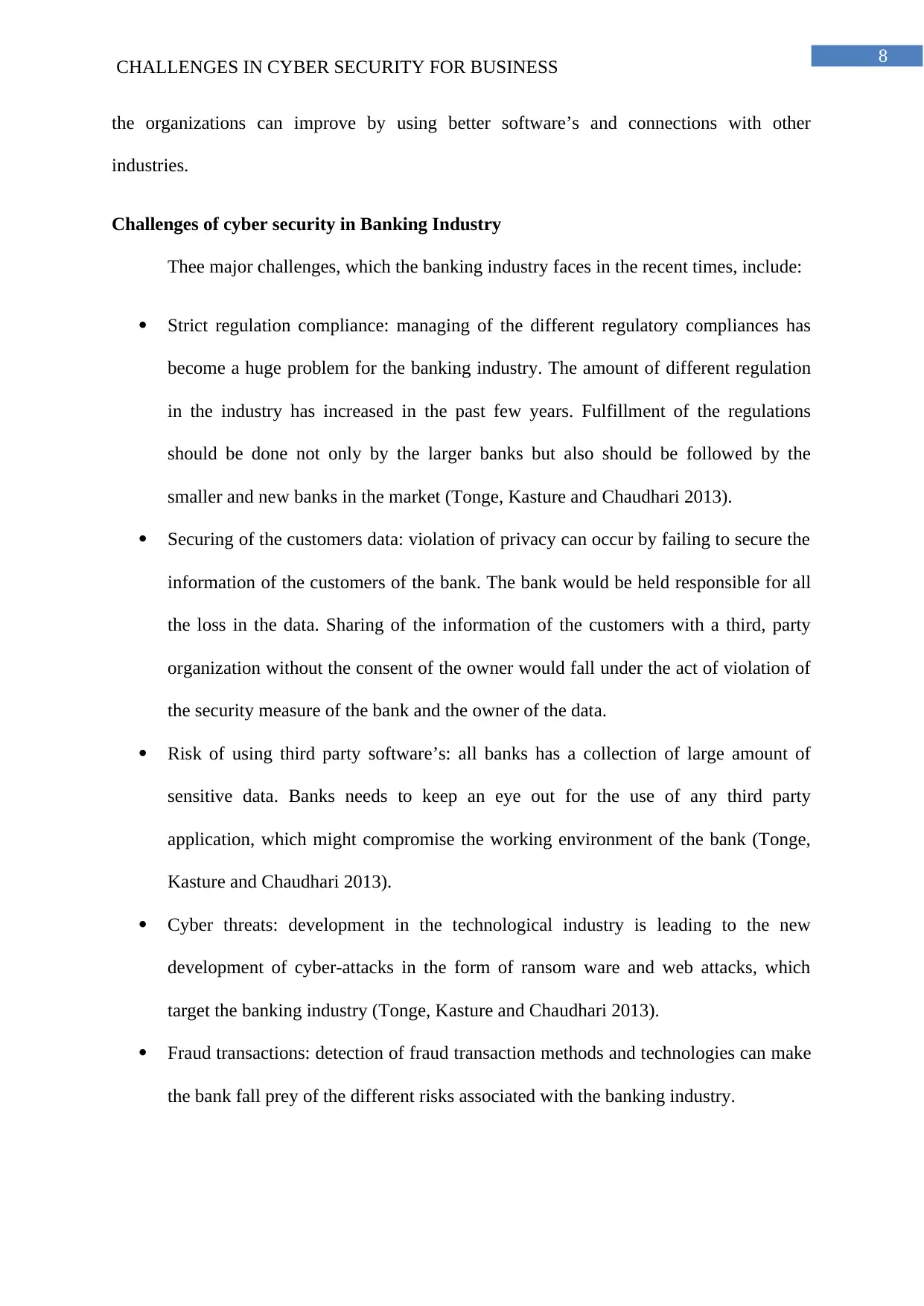
8
CHALLENGES IN CYBER SECURITY FOR BUSINESS
the organizations can improve by using better software’s and connections with other
industries.
Challenges of cyber security in Banking Industry
Thee major challenges, which the banking industry faces in the recent times, include:
Strict regulation compliance: managing of the different regulatory compliances has
become a huge problem for the banking industry. The amount of different regulation
in the industry has increased in the past few years. Fulfillment of the regulations
should be done not only by the larger banks but also should be followed by the
smaller and new banks in the market (Tonge, Kasture and Chaudhari 2013).
Securing of the customers data: violation of privacy can occur by failing to secure the
information of the customers of the bank. The bank would be held responsible for all
the loss in the data. Sharing of the information of the customers with a third, party
organization without the consent of the owner would fall under the act of violation of
the security measure of the bank and the owner of the data.
Risk of using third party software’s: all banks has a collection of large amount of
sensitive data. Banks needs to keep an eye out for the use of any third party
application, which might compromise the working environment of the bank (Tonge,
Kasture and Chaudhari 2013).
Cyber threats: development in the technological industry is leading to the new
development of cyber-attacks in the form of ransom ware and web attacks, which
target the banking industry (Tonge, Kasture and Chaudhari 2013).
Fraud transactions: detection of fraud transaction methods and technologies can make
the bank fall prey of the different risks associated with the banking industry.
CHALLENGES IN CYBER SECURITY FOR BUSINESS
the organizations can improve by using better software’s and connections with other
industries.
Challenges of cyber security in Banking Industry
Thee major challenges, which the banking industry faces in the recent times, include:
Strict regulation compliance: managing of the different regulatory compliances has
become a huge problem for the banking industry. The amount of different regulation
in the industry has increased in the past few years. Fulfillment of the regulations
should be done not only by the larger banks but also should be followed by the
smaller and new banks in the market (Tonge, Kasture and Chaudhari 2013).
Securing of the customers data: violation of privacy can occur by failing to secure the
information of the customers of the bank. The bank would be held responsible for all
the loss in the data. Sharing of the information of the customers with a third, party
organization without the consent of the owner would fall under the act of violation of
the security measure of the bank and the owner of the data.
Risk of using third party software’s: all banks has a collection of large amount of
sensitive data. Banks needs to keep an eye out for the use of any third party
application, which might compromise the working environment of the bank (Tonge,
Kasture and Chaudhari 2013).
Cyber threats: development in the technological industry is leading to the new
development of cyber-attacks in the form of ransom ware and web attacks, which
target the banking industry (Tonge, Kasture and Chaudhari 2013).
Fraud transactions: detection of fraud transaction methods and technologies can make
the bank fall prey of the different risks associated with the banking industry.
⊘ This is a preview!⊘
Do you want full access?
Subscribe today to unlock all pages.

Trusted by 1+ million students worldwide
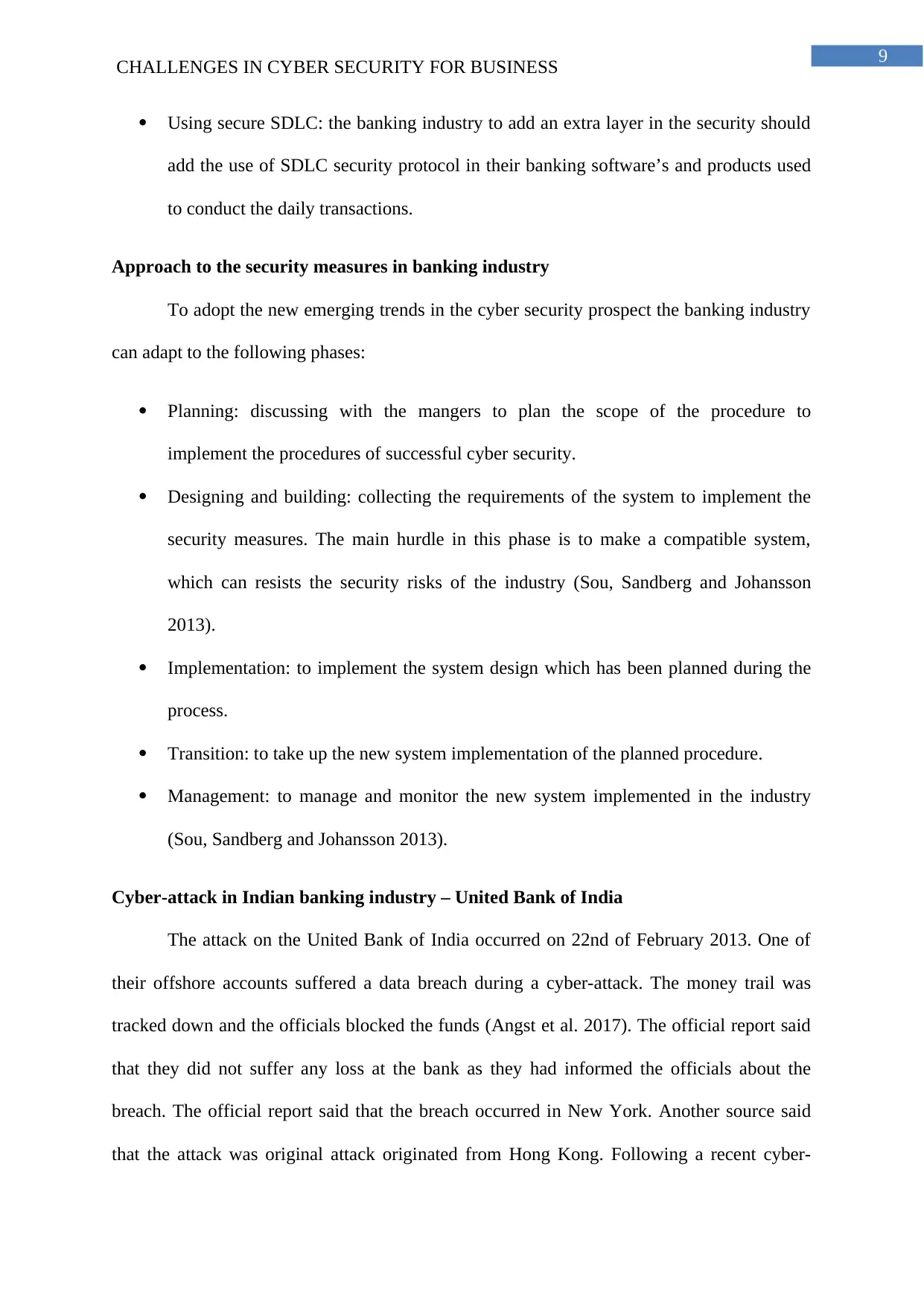
9
CHALLENGES IN CYBER SECURITY FOR BUSINESS
Using secure SDLC: the banking industry to add an extra layer in the security should
add the use of SDLC security protocol in their banking software’s and products used
to conduct the daily transactions.
Approach to the security measures in banking industry
To adopt the new emerging trends in the cyber security prospect the banking industry
can adapt to the following phases:
Planning: discussing with the mangers to plan the scope of the procedure to
implement the procedures of successful cyber security.
Designing and building: collecting the requirements of the system to implement the
security measures. The main hurdle in this phase is to make a compatible system,
which can resists the security risks of the industry (Sou, Sandberg and Johansson
2013).
Implementation: to implement the system design which has been planned during the
process.
Transition: to take up the new system implementation of the planned procedure.
Management: to manage and monitor the new system implemented in the industry
(Sou, Sandberg and Johansson 2013).
Cyber-attack in Indian banking industry – United Bank of India
The attack on the United Bank of India occurred on 22nd of February 2013. One of
their offshore accounts suffered a data breach during a cyber-attack. The money trail was
tracked down and the officials blocked the funds (Angst et al. 2017). The official report said
that they did not suffer any loss at the bank as they had informed the officials about the
breach. The official report said that the breach occurred in New York. Another source said
that the attack was original attack originated from Hong Kong. Following a recent cyber-
CHALLENGES IN CYBER SECURITY FOR BUSINESS
Using secure SDLC: the banking industry to add an extra layer in the security should
add the use of SDLC security protocol in their banking software’s and products used
to conduct the daily transactions.
Approach to the security measures in banking industry
To adopt the new emerging trends in the cyber security prospect the banking industry
can adapt to the following phases:
Planning: discussing with the mangers to plan the scope of the procedure to
implement the procedures of successful cyber security.
Designing and building: collecting the requirements of the system to implement the
security measures. The main hurdle in this phase is to make a compatible system,
which can resists the security risks of the industry (Sou, Sandberg and Johansson
2013).
Implementation: to implement the system design which has been planned during the
process.
Transition: to take up the new system implementation of the planned procedure.
Management: to manage and monitor the new system implemented in the industry
(Sou, Sandberg and Johansson 2013).
Cyber-attack in Indian banking industry – United Bank of India
The attack on the United Bank of India occurred on 22nd of February 2013. One of
their offshore accounts suffered a data breach during a cyber-attack. The money trail was
tracked down and the officials blocked the funds (Angst et al. 2017). The official report said
that they did not suffer any loss at the bank as they had informed the officials about the
breach. The official report said that the breach occurred in New York. Another source said
that the attack was original attack originated from Hong Kong. Following a recent cyber-
Paraphrase This Document
Need a fresh take? Get an instant paraphrase of this document with our AI Paraphraser
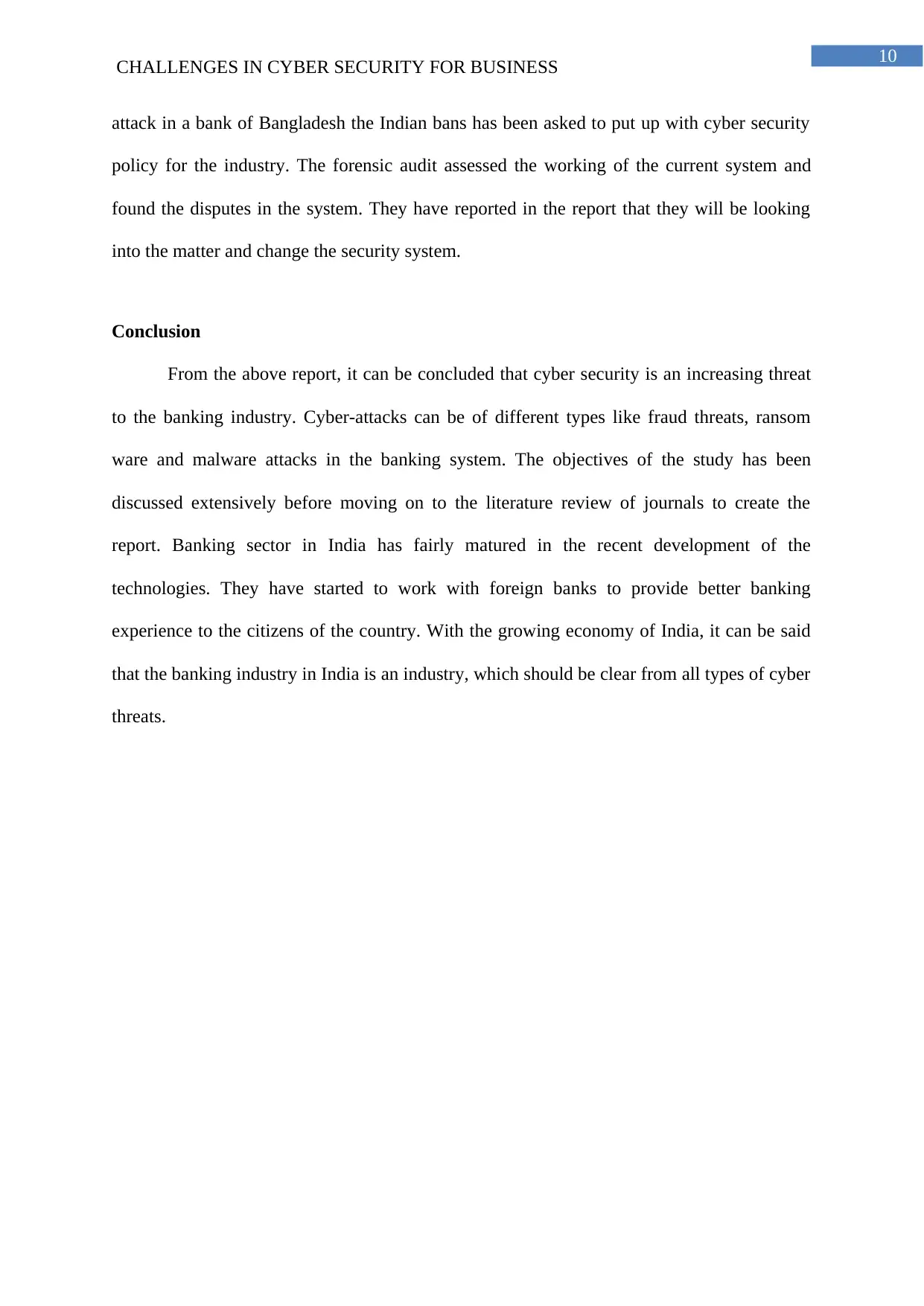
10
CHALLENGES IN CYBER SECURITY FOR BUSINESS
attack in a bank of Bangladesh the Indian bans has been asked to put up with cyber security
policy for the industry. The forensic audit assessed the working of the current system and
found the disputes in the system. They have reported in the report that they will be looking
into the matter and change the security system.
Conclusion
From the above report, it can be concluded that cyber security is an increasing threat
to the banking industry. Cyber-attacks can be of different types like fraud threats, ransom
ware and malware attacks in the banking system. The objectives of the study has been
discussed extensively before moving on to the literature review of journals to create the
report. Banking sector in India has fairly matured in the recent development of the
technologies. They have started to work with foreign banks to provide better banking
experience to the citizens of the country. With the growing economy of India, it can be said
that the banking industry in India is an industry, which should be clear from all types of cyber
threats.
CHALLENGES IN CYBER SECURITY FOR BUSINESS
attack in a bank of Bangladesh the Indian bans has been asked to put up with cyber security
policy for the industry. The forensic audit assessed the working of the current system and
found the disputes in the system. They have reported in the report that they will be looking
into the matter and change the security system.
Conclusion
From the above report, it can be concluded that cyber security is an increasing threat
to the banking industry. Cyber-attacks can be of different types like fraud threats, ransom
ware and malware attacks in the banking system. The objectives of the study has been
discussed extensively before moving on to the literature review of journals to create the
report. Banking sector in India has fairly matured in the recent development of the
technologies. They have started to work with foreign banks to provide better banking
experience to the citizens of the country. With the growing economy of India, it can be said
that the banking industry in India is an industry, which should be clear from all types of cyber
threats.
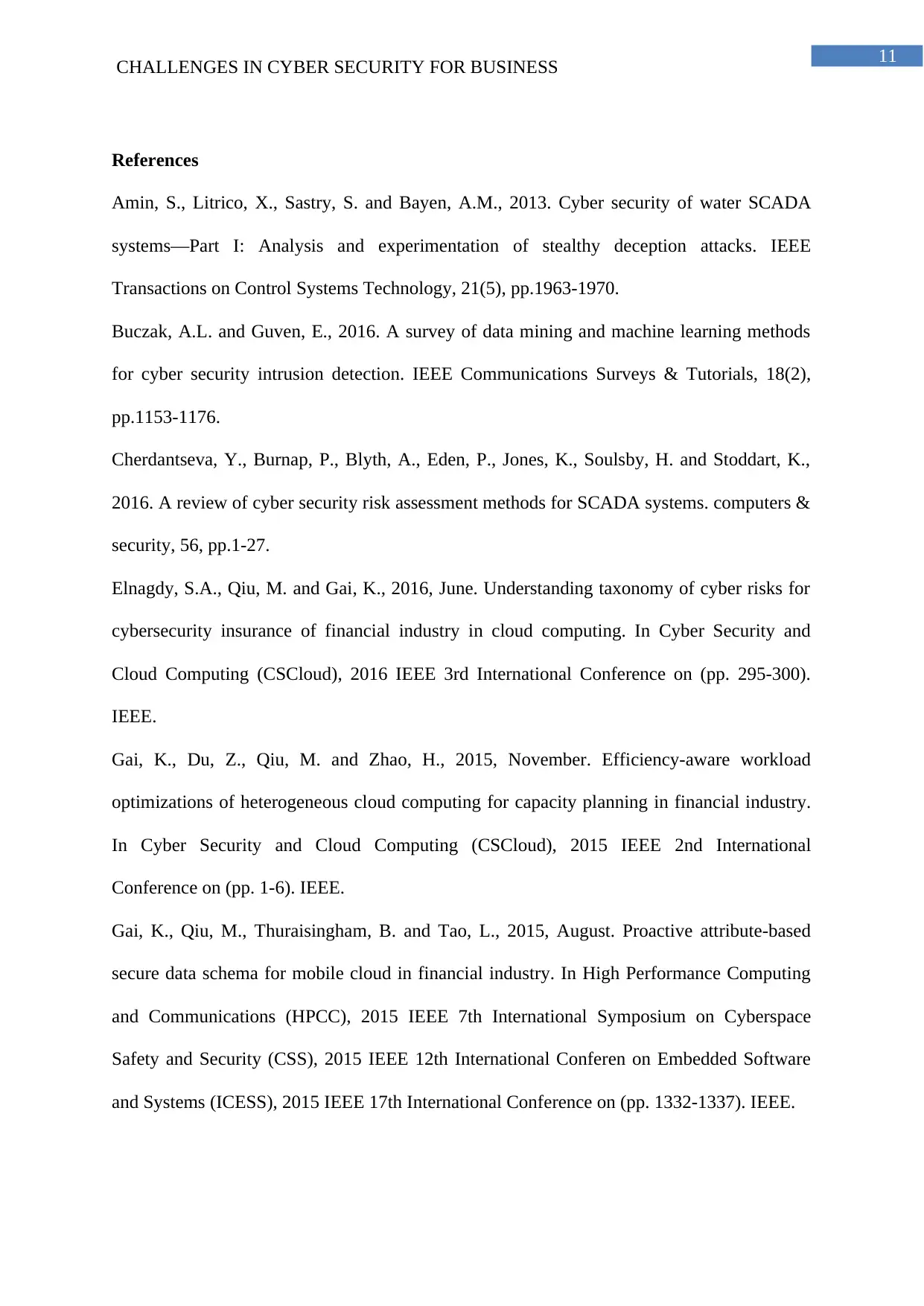
11
CHALLENGES IN CYBER SECURITY FOR BUSINESS
References
Amin, S., Litrico, X., Sastry, S. and Bayen, A.M., 2013. Cyber security of water SCADA
systems—Part I: Analysis and experimentation of stealthy deception attacks. IEEE
Transactions on Control Systems Technology, 21(5), pp.1963-1970.
Buczak, A.L. and Guven, E., 2016. A survey of data mining and machine learning methods
for cyber security intrusion detection. IEEE Communications Surveys & Tutorials, 18(2),
pp.1153-1176.
Cherdantseva, Y., Burnap, P., Blyth, A., Eden, P., Jones, K., Soulsby, H. and Stoddart, K.,
2016. A review of cyber security risk assessment methods for SCADA systems. computers &
security, 56, pp.1-27.
Elnagdy, S.A., Qiu, M. and Gai, K., 2016, June. Understanding taxonomy of cyber risks for
cybersecurity insurance of financial industry in cloud computing. In Cyber Security and
Cloud Computing (CSCloud), 2016 IEEE 3rd International Conference on (pp. 295-300).
IEEE.
Gai, K., Du, Z., Qiu, M. and Zhao, H., 2015, November. Efficiency-aware workload
optimizations of heterogeneous cloud computing for capacity planning in financial industry.
In Cyber Security and Cloud Computing (CSCloud), 2015 IEEE 2nd International
Conference on (pp. 1-6). IEEE.
Gai, K., Qiu, M., Thuraisingham, B. and Tao, L., 2015, August. Proactive attribute-based
secure data schema for mobile cloud in financial industry. In High Performance Computing
and Communications (HPCC), 2015 IEEE 7th International Symposium on Cyberspace
Safety and Security (CSS), 2015 IEEE 12th International Conferen on Embedded Software
and Systems (ICESS), 2015 IEEE 17th International Conference on (pp. 1332-1337). IEEE.
CHALLENGES IN CYBER SECURITY FOR BUSINESS
References
Amin, S., Litrico, X., Sastry, S. and Bayen, A.M., 2013. Cyber security of water SCADA
systems—Part I: Analysis and experimentation of stealthy deception attacks. IEEE
Transactions on Control Systems Technology, 21(5), pp.1963-1970.
Buczak, A.L. and Guven, E., 2016. A survey of data mining and machine learning methods
for cyber security intrusion detection. IEEE Communications Surveys & Tutorials, 18(2),
pp.1153-1176.
Cherdantseva, Y., Burnap, P., Blyth, A., Eden, P., Jones, K., Soulsby, H. and Stoddart, K.,
2016. A review of cyber security risk assessment methods for SCADA systems. computers &
security, 56, pp.1-27.
Elnagdy, S.A., Qiu, M. and Gai, K., 2016, June. Understanding taxonomy of cyber risks for
cybersecurity insurance of financial industry in cloud computing. In Cyber Security and
Cloud Computing (CSCloud), 2016 IEEE 3rd International Conference on (pp. 295-300).
IEEE.
Gai, K., Du, Z., Qiu, M. and Zhao, H., 2015, November. Efficiency-aware workload
optimizations of heterogeneous cloud computing for capacity planning in financial industry.
In Cyber Security and Cloud Computing (CSCloud), 2015 IEEE 2nd International
Conference on (pp. 1-6). IEEE.
Gai, K., Qiu, M., Thuraisingham, B. and Tao, L., 2015, August. Proactive attribute-based
secure data schema for mobile cloud in financial industry. In High Performance Computing
and Communications (HPCC), 2015 IEEE 7th International Symposium on Cyberspace
Safety and Security (CSS), 2015 IEEE 12th International Conferen on Embedded Software
and Systems (ICESS), 2015 IEEE 17th International Conference on (pp. 1332-1337). IEEE.
⊘ This is a preview!⊘
Do you want full access?
Subscribe today to unlock all pages.

Trusted by 1+ million students worldwide
1 out of 14
Related Documents
Your All-in-One AI-Powered Toolkit for Academic Success.
+13062052269
info@desklib.com
Available 24*7 on WhatsApp / Email
![[object Object]](/_next/static/media/star-bottom.7253800d.svg)
Unlock your academic potential
Copyright © 2020–2025 A2Z Services. All Rights Reserved. Developed and managed by ZUCOL.





